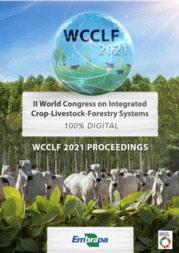Yes! It's possible to produce soybeans and corn in integrated crop-livestock-forest systems after thinning.
Yes! It's possible to produce soybeans and corn in integrated crop-livestock-forest systems after thinning.
Autoria: MAGALHÃES, C. A. de S.; ZOLIN, C. A.; ARAGÃO, W. F. D. X.; FARIAS NETO, A. L. de
Resumo: Abstract: In 2011, a large-scale (72 ha) and long-term experiment was established in Sinop, Mato Grosso, Brazil, with the objective of evaluating different grain production systems. All systems with the presence of trees were implanted in the configuration of triple groves eucalyptus with spacing of 3.5 m x 3.0 m x 30 m (270 trees/ha). After the 5th year, we made 2 types of thinning: selective thinning, removing 50% of the trees, maintaining the configuration of triple lines (135 trees/ha); systematic thinning, with removal of the two side lines (90 trees/ha remaining). After the 8th year, the systems that were with triple rank (135 trees/ha) were again thinned, now systematically, leaving 45 trees/ha. Soybeans produced at the same level as the single system in the first three years, while corn only in the first two years. After the first thinning, there was a recovery of grain yield levels for two years for soybean and for one year for corn, in the system with systematic thinning. And after the thinning in 8th year, soybean returned to the levels of the single system as well, at least for 2 years and corn in first year as well.
Ano de publicação: 2021
Tipo de publicação: Artigo em anais e proceedings
Unidade: Embrapa Agrossilvipastoril
Palavras-chave: Ilpf, Integração lavoura-pecuária-floresta, Mato Grosso, Sinop-MT, Sistemas de produção integrado
Observações
1 - Por padrão são exibidas publicações dos últimos 20 anos. Para encontrar publicações mais antigas, configure o filtro ano de publicação, colocando o ano a partir do qual você deseja encontrar publicações. O filtro está na coluna da esquerda na busca acima.
2 - Para ler algumas publicações da Embrapa (apenas as que estão em formato ePub), é necessário ter, no celular ou computador, um desses softwares gratuitos. Sistemas Android: Google Play Livros; IOS: iBooks; Windows e Linux: software Calibre.
Acesse outras publicações
Acesse a Base de Dados da Pesquisa Agropecuária (BDPA) para consultar o acervo completo das bibliotecas da Embrapa.

